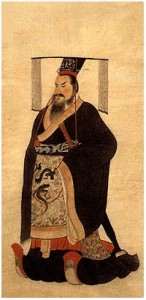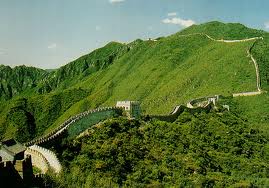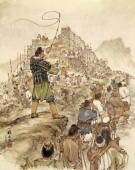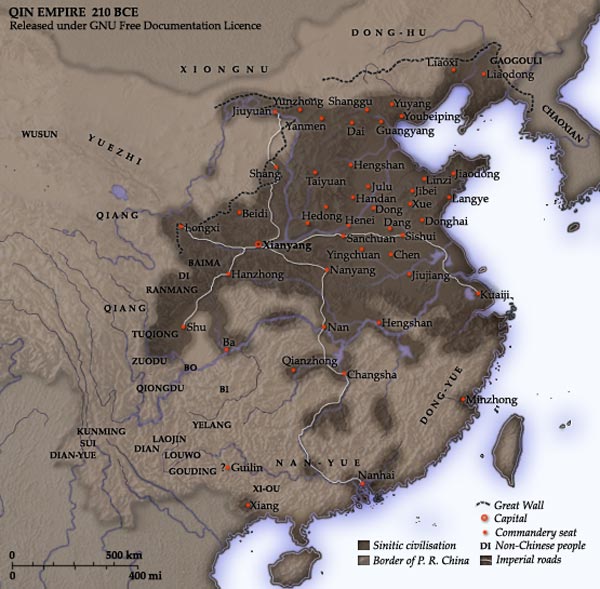The Qin Dynasty traces its beginning to the granting of a land by the last heir to the Zhou Dynasty to one of its Dukes, Duke Zhuang. Zhuang’s son was made the leader of an expedition marching eastward from the capital during which he established the State of Qin. It was this state that had grown and conquered its neighbours until it conquered all the states.
Warring States
During the period of warring states, there were several states vying for dominance and Qin was one of them. It was defeated by other states scheming together and was also beset by internal dissents pertaining to succession at several points. It was able to conquer all of the other under the wise leadership of Ying Zheng (Qin Shi Huang). This was the first dynasty of a unified China.
 The strategy was to align its state with one state to defeat and conquer another. It started with the state of Hao, followed by Zhao and Yan. The neighboring states of Wei Chu and Qi shortly followed. Ying Zheng implemented reforms and measures designed to quell any uprisings at its roots and to maintain the stability of his rule. His reforms were both straightforward and heavy handed. They reached the political and economic spheres as well as pervaded the literary arts and science.
The strategy was to align its state with one state to defeat and conquer another. It started with the state of Hao, followed by Zhao and Yan. The neighboring states of Wei Chu and Qi shortly followed. Ying Zheng implemented reforms and measures designed to quell any uprisings at its roots and to maintain the stability of his rule. His reforms were both straightforward and heavy handed. They reached the political and economic spheres as well as pervaded the literary arts and science.
The End of Feudalism in the Qin Dynasty
In the political sphere, feudalism was abandoned altogether. The institution of vassals and landowners was abolished. This drew the loyalty of the peasants from their landlords back to the emperor, the one central ruler. Everything reverted to the central government including the allegiance of the citizens. This is how the previously warring states were unified by the Qin Dynasty.
This newly found control of the masses and unity of the empire paved the way for the completion of the emperor’s projects which were always both elaborate and ambitious, not to mention the incredibly large scale. One, and perhaps the most remarkable, of which is the Great Wall of China.
The Great Wall of China

The Great Wall of China was, in the beginning, not meant to fence in all of the empire. It started with several spattering of walls between the Warring States meant to fortify each of their defences. Although it was started in the previous dynasty and completed two dynasties hence, it became the “great wall” because of the unifying intent incorporated into it by the Qin Dynasty. This wall would see itself elevated to the 7 manmade wonders of the modern world many centuries later.
The New Market Economy
The emperor, Ying Zheng had a knack for organization and, needless to say, unification of everything. He reorganized the markets and trade and made them more efficient by implementing a uniform standard in trade and making the currency more secure. He also ordered a new and better system of writing for all of his empire. He made Qinzhuan the standanrd writing style for the empire.
All of these efforts lead to the betterment of the empire’s economy. Among the emperor’s efforts in advancing his beloved empire was expansion. He wielded in his power a revolutionary army with more military strength than any other kingdom at the time. His military had the most advanced weapons but also operated it with a heavy hand.
The Philosophy of Legalism
The emperor and the prime minister of the Qin Dynasty followed but one philosophy: Legalism. This is a political philosophy that was based mostly on utility. It did not concern itself with religion or the afterlife. The main idea was to make a system that will make and culture ideal citizens who will subordinate their will to that of the state.
The Qin dynasty was seemingly a jealous one. The emperor always kept a wary eye out for and possible beginnings of a conquest to usurp him. He was so apprehensive that he went to the extent of having all weapons and other metals not under the use and operation of his army melted and destroyed. Despite the many his many contributions to the development of the empire, the emperor was rather despotic.
Mandatory Taxes and Forced Labor
 He used corvee labor, more commonly known as mandatory labor, to build luxurious palaces and structures to satisfy his whim. The now historical Terra-Cotta army was one of the better fruits of these whims. He also tried to keep his citizens from intellectual growth. He did this by burning the scrolls and books containing the many different schools of philosophy circulating at the time and even imposed the practice of burying the scholars who started them. Many of the philosophies and schools of thought at the time saw its end during this period.
He used corvee labor, more commonly known as mandatory labor, to build luxurious palaces and structures to satisfy his whim. The now historical Terra-Cotta army was one of the better fruits of these whims. He also tried to keep his citizens from intellectual growth. He did this by burning the scrolls and books containing the many different schools of philosophy circulating at the time and even imposed the practice of burying the scholars who started them. Many of the philosophies and schools of thought at the time saw its end during this period.
The empire that was finally unified was unfortunately made to suffer a woeful plight. They had to face burdensome taxes, which were spent on the emperor’s efforts to fortify his military and fund his caprices of infrastructures. They were also subjected to labor that was not only unjustly difficult but also forced. They were also compelled to perform military service even when they did not want to. All this sprung from and was justified by the principle, or rather by the misuse of the principle, of legalism.
In spite of all of that, the fall of the Qin Dynasty was not caused by external forces. It was ultimately brought about by the selfish political ambitions of the first emperor’s two political advisers. These two political advisers saw to it that the king’s son would be throned after his death. They did so with the intention of influencing him in governing the empire. Eventually, the two ended up killing each other, leaving an emperor, who was accustomed to taking his cue from them, lost.
This had made the empire substantially weaker. So weak, in fact, that lieutenant of Chu was able to wrest power from his hands shortly after. This turn brought about the end of the Qin Dynasty and marked the rise of the Han Dynasty.
Despite the short life of the empire and the apparent imperfections of its rulers, the modern world is embellished with its accomplishments, including the only structure on earth said to be visible from the moon.
